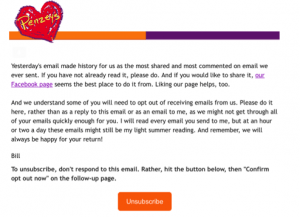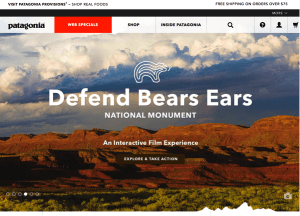In spite of the old saying to avoid talking politics and religion at the dinner table, politics has always been a topic that made its way into conversations in all sorts of contexts (not all of them appropriate to the topic). But this past November, for people in the United States in particular, it suddenly became much more difficult not to talk about politics.
The current political climate is more polarized than ever and inspires strong emotions from people on both sides. In response, some brands have seen it as an opportunity to be more open about their politics.
It’s a risky move.
On the one hand, making politics a part of your marketing message can inspire more loyalty from the customers who share your politics. But as a number of brands have seen in the past few months (and to a lesser extent, before as well), it can also provoke boycotts from those who oppose the politics you purport.
Worse, if your attempt isn’t thought through or comes off as inauthentic (or both), you can end up driving away both sides at once. Pepsi got a serious lesson in that with its recent ad starring Kendall Jenner which made a tone-deaf attempt to capitalize on the Black Lives Matter movement.
But sometimes the risk does pay off and expressing your politics can help you gain a closer connection with your customers – something all brands hope and work so hard for. It’s tricky, but it can be done.
Here are few important guidelines you have to follow if you want to get it right.
Consider your audience.
The first rule of marketing in all contexts has to be given proper weight in considering how to address politics in your marketing as well. If your audience is predominately conservative and you take a liberal stand, or vice versa, you’ll be alienating the main people who buy from you.
If you know your business doesn’t really share the values of your target audience, then you’re better off steering clear of any political messaging altogether. If you have a pretty good idea that you and your customers are on the same page, then openly addressing political issues in your marketing could be a savvy move.
Thinx knows its audience is mostly young, mostly female, and mostly progressive in their politics. As a result, it can safely base the brand’s marketing newsletter entirely around feminist issues and trust that their customers will be more likely to nod their heads in agreement, rather than get angry at seeing politics they don’t relate to represented.

Thinx has a specific enough audience (people with periods – so mostly women under a certain age) that they have it easier than most brands when it comes to knowing how their customers are likely to respond to political messaging. If you’re less sure of how your audience will respond to a political message, consider doing some customer research before taking that step.
Note: If your brand feels that your political views are important enough that it’s worth taking the risk of losing some customers, then that’s another issue entirely. If you’re prepared to risk profits to stand up for something, then it may be ok to skip that customer research and just go for it.
Be thoughtful.
Any political messaging that’s built into marketing has to be authentic. If it seems like you’re trying to take advantage of a political moment that affects people’s lives in a significant way, you risk inspiring cynicism and anger rather than the sense of camaraderie you’re hoping for.
Penzey’s declared their opposition to the Republican party in clear terms back in November, fully expecting the move to be a risk, but clearly making the case for why they felt it was an important move to take in an email to their subscribers.
They did receive some angry responses, but the email ended up being the most shared email they’d ever sent and most of their email subscribers stuck with them.


The message they sent made it clear that they really thought through the decision of taking this step. They worked out what they wanted to say and how, and crafted their message in a way that made where they stood clear.
And they tied it back to the brand by pointing to the larger culture of cooking: “The kindness of tens of thousands of generations of cooks created our humanity, but racism, sexism, and homophobia can all very quickly unravel all the goodness cooking puts out into the world. As the voice of cooks, we will never sit idly by while that happens.”
This wasn’t a blind grab for attention by referencing something in the news, it was smart, well thought-out marketing that took a risk, made a stand, and paid off.
Be ready to put your money where your mouth is.
Saying you back a particular issue or cause can let your customers know where you stand, but actively donating to that cause or showing a willingness to take steps that could lose you money in support of it tells your customers so much more.
Patagonia is a brand that appeals to people that love the outdoors – a group which has a big overlap with people who care about the environment, for obvious reasons. It makes a lot of sense for them as a company to take a stand for the environment. And their website puts their opinions on the subject front and center.

But they’re still a brand out to make money and it could be easy for their customers to roll their eyes and see their mentions of environmental issues as pandering.
It becomes harder for customers to maintain that kind of cynicism when they see the company put their money where their mouth is with their $10 Million for the Planet Initiative. The company committed to donating all their sales from Black Friday to grassroots organizations working on environmental issues. Their customers came out in droves that day and helped the brand make over $10 million to give to a good cause.

The move showed their customers they were prepared to do more than just talk.
Addressing political issues is decidedly not a good move for every brand. But if you consider your audience and carefully think through both the how and why of taking a political stand, it could be worth it for your brand. In this political climate, it’s definitely a risk, but it’s one that could lead to a stronger connection with your audience, a more meaningful positioning for your brand, and the moral sense of doing something that matters – not a feeling that regularly comes with marketing work.

 marketers in a number of different forms. One of those is
marketers in a number of different forms. One of those is  promotion
promotion visible and reaching customers on the web. But a lot of people doing it are struggling to see the kind of results they want.
visible and reaching customers on the web. But a lot of people doing it are struggling to see the kind of results they want.